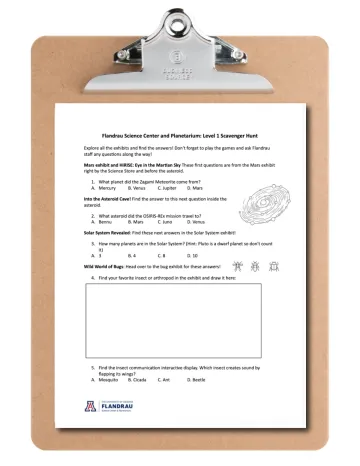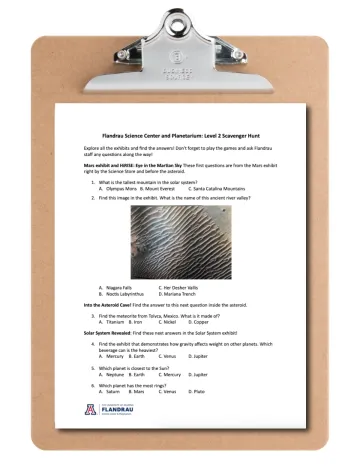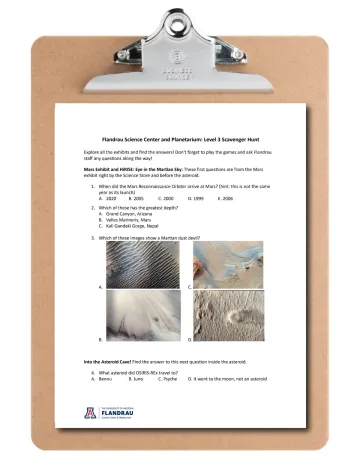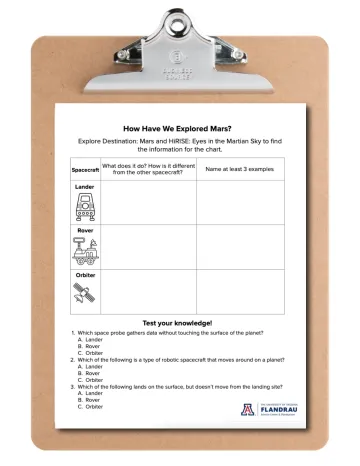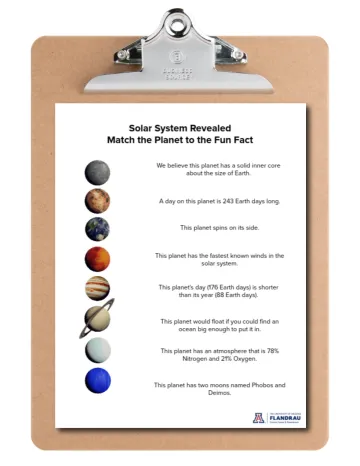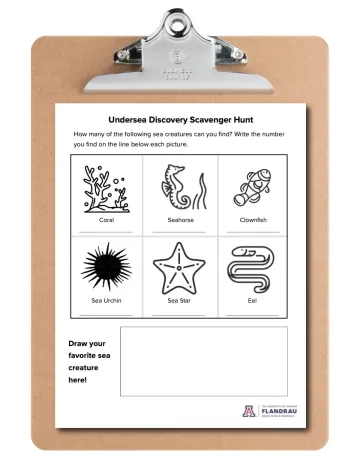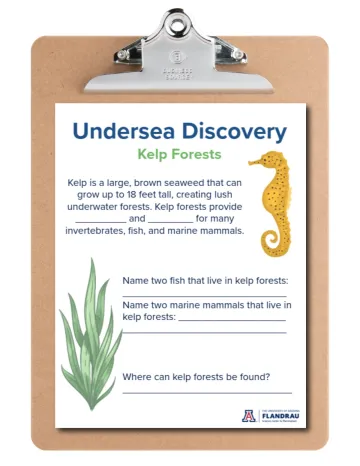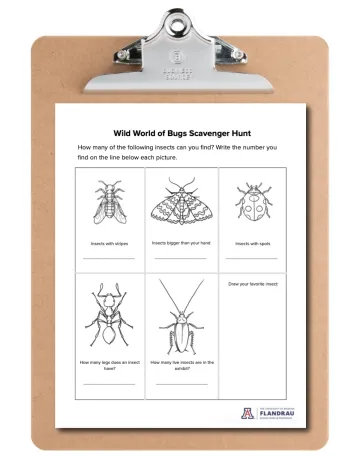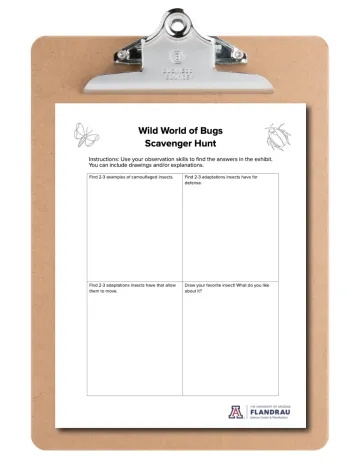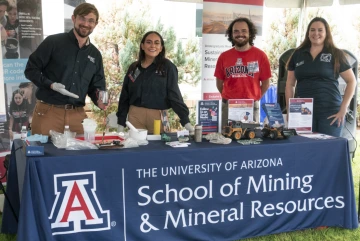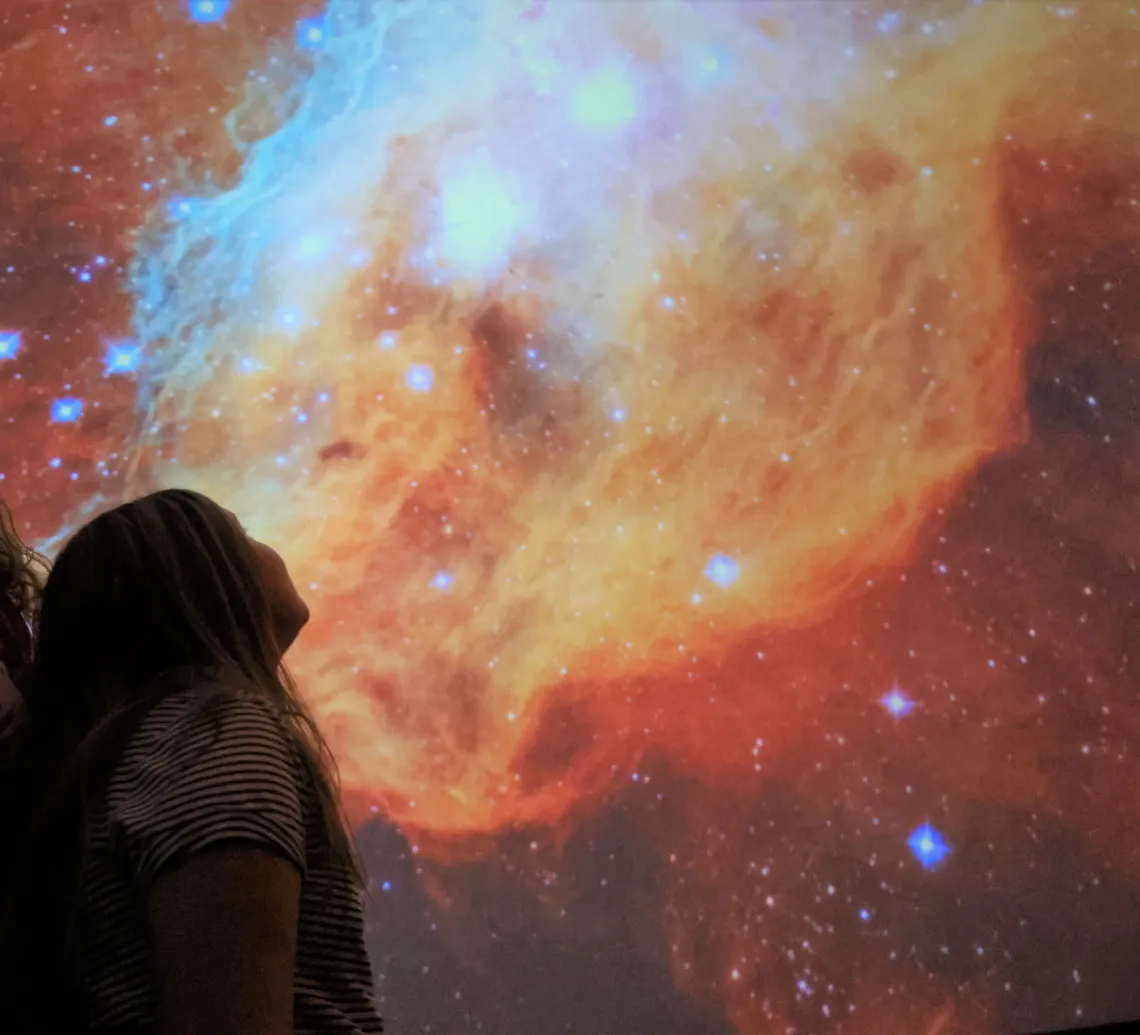
Take the Fun from Flandrau to the Classroom
Whether you're taking your class to a Discovery Workshop or seeing a show in the Eos Foundation Planetarium Theater, we have standards-aligned resources for before, during, and after your field trip.
Sign up for our Educator Newsletter to be notified of field trip registration openings, new resources, and more.
Exhibit Experience Resources
To schedule an Exhibit Experience field trip, visit our Classic Field Trip page.
Check back after the opening of the Universe of Science for resources on our new exhibit!
Planetarium Show Resources
To schedule a Planetarium Show field trip, visit our Classic Field Trip page.
- Back to the Moon For Good
- Big Astronomy
- Black Holes: The Other Side of Infinity
- Expedition Reef
- Fractal Explorations
- From Earth to the Universe
- IBEX: Search for the Edge of the Solar System
- Legends of the Night Sky: Orion
- Max Goes to the Moon
- Mysteries of the Unseen World
- One World, One Sky: Big Bird's Adventure
- Perfect Little Planet
- Phantom of the Universe: The Hunt for Dark Matter
- Season of Light
- Sunstruck
- 5000 Eyes
Discovery Program Resources
For more information on Discovery Programs or to register for a field trip, visit our Discovery Program page.
Meet the Experts at the University of Arizona studying Subsurface Microbe-Rock-Fluid Systems: Scientist Lydia Bailey
Introduction to the Deep Biosphere
Post-Visit Worksheets
Build Your Own Critical Zone Post-Visit Activity
Even More Learning!
Department of Entomology & Arizona Cooperative Extension:
Check back soon for Marine Discovery resources!
Check back soon for Physics Discovery resources!
Check back soon for Psychology Discovery resources!
Other Things To Do at the University of Arizona
Are you hoping to expand your Flandrau field trip to include other University of Arizona experiences? Look no further! Check out these other attractions near us with included distance and walking time estimates.
Subject to change. If you’d like your main-campus University of Arizona attraction to be added to this page, please email julietteverley@arizona.edu.
No Reservation Required
Please visit their website before visiting. Not all group sizes can be accommodated.
The Moon Tree: Directly between Flandrau and the Kuiper Building lives a tree grown from a seed that traveled to the moon on Apollo 14. Teach your students about the history of moon trees while you eat lunch or snack outside of Flandrau.
NEW! Flandrau now has a second moon tree to the north of the building.
Campus self-guided tour: Take a tour of the University of Arizona and learn more about our traditions, history and the Wildcat Spirit that make our university so special!
Campus Arboretum self-guided tour: Choose from Arboretum History, Sonoran Native Plants, or Trees Around the World tours.
Scale Solar System Walk: The model extends 0.68 miles along the University of Arizona Mall, starting with the Sun, located outside the Kuiper Space Science Building.
College of Optical Science self-guided tour: 0.1 mile, 3 minute walk.
The University of Arizona Mall: the campus mall, directly across the street from the south-side of Flandrau, is a great place to take your class to play games or eat a snack while you wait for your Flandrau field trip.
Reservation Required
Worlds of Words Field Trips: Worlds of Words: Center of Global Literacies and Literatures builds bridges across global cultures through children’s and adolescent literature. 0.3 mile, 6 minute walk.
African American Museum of Southern Arizona: AAMSAZ will present a cultural and educational experience by providing items of significance with stories of struggles and triumphs presented by knowledgeable volunteers and staff. 0.3 mile, 7 minute walk.
The University of Arizona Museum of Art: The University of Arizona Museum of Art advances the academic and research mission of the university, inspires critical dialogue among campus and community audiences, and celebrates art as essential to our lives through the stewardship and interpretation of its expanding collection of art and archives. 0.6 mile, 14 minute walk.
The University of Arizona Poetry Center: The Poetry Center is a leading literary institution and a living archive of poetry. As a premier example of a thriving public/private partnership, the Poetry Center connects the University of Arizona with the greater literary community in Tucson and beyond. 0.4 mile, 10 minute walk.
Richard F Caris Mirror Lab: At The University of Arizona's Richard F. Caris Mirror Laboratory, a team of scientists and engineers are making giant, lightweight mirrors of unprecedented power for a new generation of optical telescopes. 0.4 mile, 8 minute walk.
Laboratory of Tree-Ring Research: The LTRR is a preeminent center of dendrochronology – using the information stored in the annual rings of trees to understand and quantify interactions among our Earth’s climate, ecosystems, and societies. 0.6 mile, 13 minute walk.
Coit Museum of Pharmacy & Health Sciences: The Coit Museum of Pharmacy & Health Sciences is home to one of the world’s leading pharmacy collections, offering a unique visitor experience. 0.6 mile, 13 minute walk.


